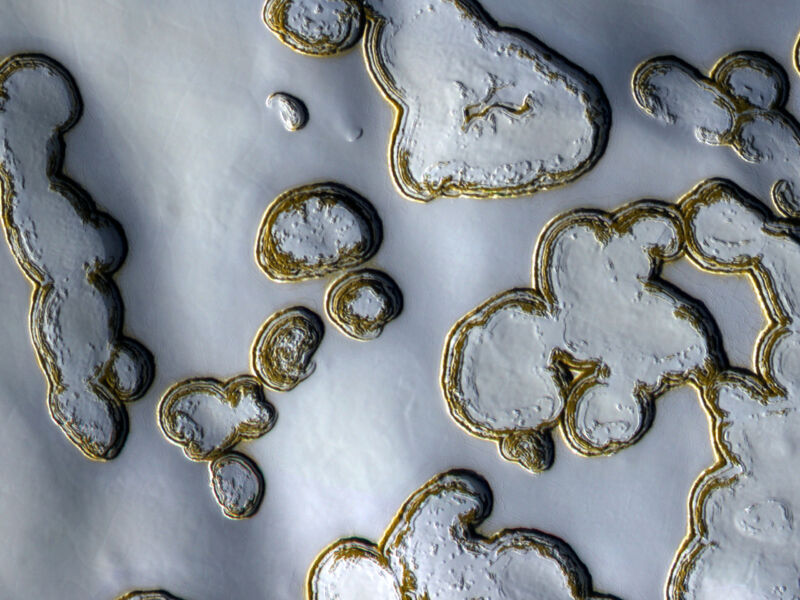7.10.2023
The red planet has white ice caps that retreat and expand with the seasons.

Some of the ice near the South Pole of Mars stays around all year long.
Mars is a vast, frozen desert. Nowhere is that more evident than at its poles, which are the coldest regions on the planet. However, it looks like the weather forecast for its harsh winters and slightly more forgiving springs could be different from we thought.
Like Earth, Mars has a volatile cycle that sees snow and ice levels fluctuate as temperatures plummet in the winter and start to rise again in the spring. Unlike Earth, Martian snowfall includes CO2 snow and is influenced by different phenomena. Now, a team of researchers led by Haifeng Xiao of Berlin Technical University in Germany is reexamining the change in snowfall over the course of a year at the Martian north pole. Their findings suggest that forces such as sublimation might mean there is more snow in the winter—and less in the spring—than previously thought.
“We propose to use the shadow variations [of ice blocks] to infer the seasonal depths at high polar latitudes,” Xiao and his team said in a draft manuscript recently published in the Earth and Space Science Open Archive.
Not like Earth
How snow accumulates on Mars may seem alien compared to the way it happens on Earth. The composition of Martian snow explains why it can snow in regions on Mars where conditions would make it nearly impossible for snow to form here on our planet. Earth snowfall requires the presence of atmospheric water, which is why frigid but otherwise dry areas do not see much of the white stuff. While water ice and snow exist on Mars, dry areas may still experience a buildup of CO2 snow and ice. Frozen carbon dioxide sublimates instead of melting when it gets too warm. Therefore, both sublimation and evaporation influence how much snow and ice buildup there is on Mars during a given season.
There are other phenomena affecting Martian snow and ice accumulation that do occur on Earth but are still different on Mars. Katabatic winds, which arise from the sinking of cold air that then spirals furiously across the ice, are found at the poles on Earth, but they have twice to three times the strength on Mars. This is due largely to the red planet’s extremely thin atmosphere. On Mars, katabatic winds also affect larger regions than they do on Earth, blowing huge troughs of ice and snow that can be up to 10 km (about 6.2 miles) wide and 1 km (about .62 miles) deep.
Still, some of the ways that ice and snow accumulate on Mars mostly mirror effects on Earth. Solar heat becomes stored in regolith below the snow and ice during the summer, and snow around a large rock will vanish as late as the fall because so much heat is still retained by the rock. Though moating (the empty space where the snow once was appears like a moat around the rock) generally happens the same way as it does on our planet, the difference on Mars is that ice and snow usually sublime from the warm area as opposed to melting and evaporating on Earth. Crowning ice caps, which form over rocks in the winter after heat has escaped from the underlying rock, can also be found on Earth.
Xiao and his team wanted to estimate the overall accumulation of snow and ice on the Martian north pole and compare their estimate to previous observations from NASA’s MOLA (Mars Orbiter Laser Altimeter) spacecraft. They tested for the depth of seasonal deposits of snow by measuring the shadows cast by ice blocks in the North Pole Layered Deposits, as seen in hi-res NASA HiRISE (High Resolution Imaging Experiment) images. As temperatures changed over the course of a Martian year, or sol, these deposits would evolve, and so would their shadows. Snowfall and depth predictably decreased from winter to spring.
Peak accumulation
What was less predictable was the amount of snow and ice present at certain times. “The large snow depth measured makes us wonder if snowfalls are more frequent and violent than previously thought,” Xiao and his team said in the same study, later stating that snow in the later years studied was deeper than expected.
There were some obstacles. Ice crowns did sometimes get in the way, as they made ice blocks and snow-covered rocks thicker, which meant they cast longer shadows. The absence of snow in moats around rocks reduced shadows and also had to be corrected for. Overall, uncertainties were less than a meter (about three feet)—which is substantial given the amount of snow that fell.
So how much snow can we expect on Mars each year? At its highest, the thickness of Martian snowfall is close to a meter in winter, decreasing to .21 m (about .7 foot) in spring and continuing to drop throughout summer until colder weather sets in. Snowfall contributes significantly more to total accumulation than frosts that directly condense on the surface.
While the snowfall on Mars would have easily made for many snow days (at least before the Internet made remote school common), Xiao thinks that further study of the variations of snow and ice depth on Mars may someday reveal more about the planet’s often mysterious insides. The snow still has secrets to tell.
Quelle: arsTechnica

